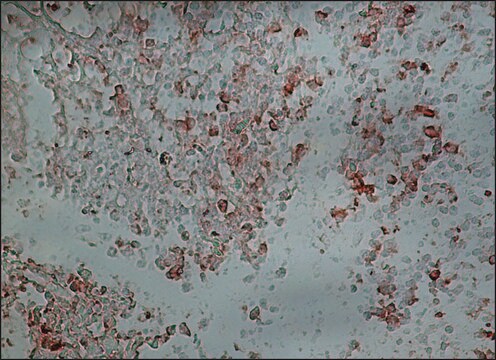AP107P
Rabbit Anti-Goat IgG Antibody, Fc, HRP conjugate
1.0 mg/mL, Chemicon®
About This Item
Produits recommandés
Source biologique
rabbit
Niveau de qualité
Conjugué
peroxidase conjugate
Forme d'anticorps
F(ab′)2 fragment of affinity isolated antibody
Type de produit anticorps
secondary antibodies
Clone
polyclonal
Espèces réactives
goat
Fabricant/nom de marque
Chemicon®
Concentration
1.0 mg/mL
Technique(s)
ELISA: suitable
western blot: suitable
Conditions d'expédition
wet ice
Modification post-traductionnelle de la cible
unmodified
Catégories apparentées
Spécificité
Application
Immunohistochemistry 1:500 - 1:5,000
Optimal working dilutions must be determined by the end user.
Secondary & Control Antibodies
Fragment Specific Secondary Antibodies
Forme physique
RECONSTITUTION:
Reconstitute with sterile distilled water to match the volume indicated on the label. Centrifuge product if it is not completely clear after standing for 1-2 hours at room temperature.
Stockage et stabilité
WARNING:
Use of sodium azide as a preservative will substantially inhibit the enzyme activity of HRP.
Informations légales
Clause de non-responsabilité
Vous ne trouvez pas le bon produit ?
Essayez notre Outil de sélection de produits.
Code de la classe de stockage
11 - Combustible Solids
Classe de danger pour l'eau (WGK)
WGK 3
Certificats d'analyse (COA)
Recherchez un Certificats d'analyse (COA) en saisissant le numéro de lot du produit. Les numéros de lot figurent sur l'étiquette du produit après les mots "Lot" ou "Batch".
Déjà en possession de ce produit ?
Retrouvez la documentation relative aux produits que vous avez récemment achetés dans la Bibliothèque de documents.
Notre équipe de scientifiques dispose d'une expérience dans tous les secteurs de la recherche, notamment en sciences de la vie, science des matériaux, synthèse chimique, chromatographie, analyse et dans de nombreux autres domaines..
Contacter notre Service technique
